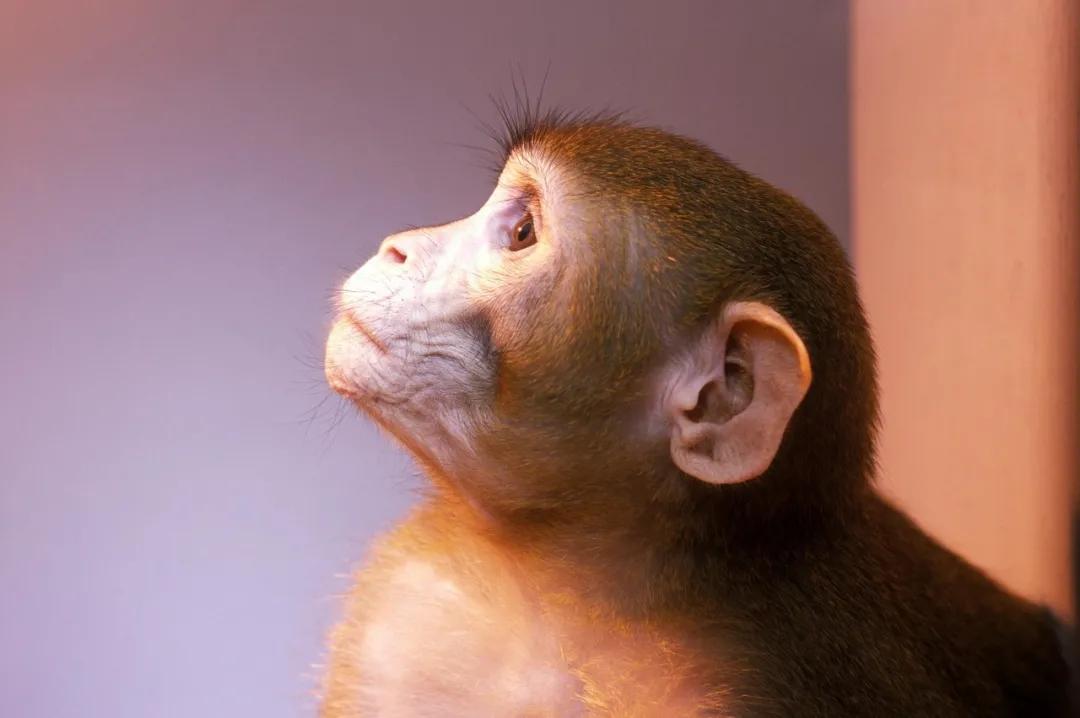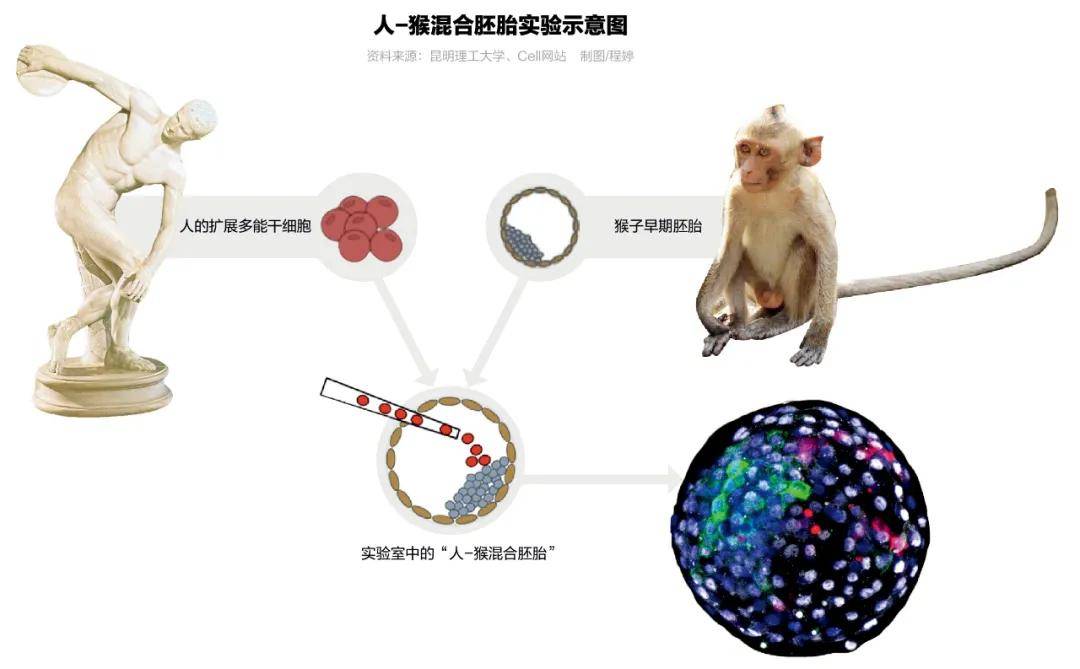
Picture/Picture Worm Creative
What does “human-monkey hybrid embryo” mean?
Our reporter/Peng Danni Li Mingzi
Issued in the 993th issue of China News Weekly on 2021.4.26
By implanting human stem cells into embryos of other animals, we may one day cultivate new organs in animals for patients with heart or kidney failure. In the process of moving towards this ultimate goal, Chinese and American scientists succeeded in cultivating a “human-monkey hybrid embryo” with a higher survival rate for the first time.
On April 15, the Institute of Primate Translational Medicine of Kunming University of Science and Technology and the provincial and ministerial departments jointly established the State Key Laboratory of Non-human Primate Biomedicine Ji Weizhi, Niu Yuyu, Tan Tao, Dai Shaoxing’s research group and the Salk Institute of the United States The staff published an article in the journal Cell, assessing the chimeric ability of human expanded pluripotent stem cells (hEPS) in cynomolgus monkeys. It has aroused ethical discussions and concerns among the public: this is a “human-monkey hybrid.” ? Wang Xiaoqun, a researcher at the Beijing Institute of Biophysics, Chinese Academy of Sciences, explained to China News Weekly that, unlike this shocking claim, this experiment explored whether a small number of human embryonic stem cells fused with monkey early embryos can differentiate with the embryos. , This is actually just a proof of concept.
Xeno-chimerism research: from mice to monkeys
Since the 1970s, scientists from all over the world have been using heterogeneous chimeras, such as sheep-goat chimeras, rat-mouse chimeras, etc., to answer basic developmental biology questions, and they have produced some exciting results. . In 2017, scientists transplanted pancreas developed from mouse stem cells into rat embryos, curing the latter’s diabetes. Embryos containing cells from different species are called “chimera embryos”.
At present, mice are the main mixed embryo host, but due to the large difference in embryo size and gestation period between rodents and humans, it is necessary to find other more suitable chimeric hosts. The first research on chimerism in large animals was carried out by Belmont, a professor at the Salk Institute for Biology in the United States, who was also one of the authors of this paper.
In 2012, Japanese researcher Shinya Yamanaka won the Nobel Prize for his research on induced pluripotent stem cells (iPSCs). His research shows that the expression of four transcription factors in mature cells can transform mature cells into induced pluripotent stem cells with embryonic morphology. This gave Belmont an enlightenment. If these human induced pluripotent stem cells are transplanted into animals, can they replicate the development of human embryos in animals?
In 2017, Belmont and his colleague Wu Jun and others injected human stem cells into pig embryos. The paper was published in the journal Cell. At the time, Belmont said that the ultimate goal of the research was to grow human cells, tissues and organs for transplantation in animals. However, because the two are far from each other, there is a big evolutionary difference. After the embryo develops in the sow for 3 to 4 weeks, only one cell per 100,000 cells belongs to human beings, so this goal is still far away. .
What happens if human stem cells are placed in monkey embryos that are more closely related to humans? Wu Jun, one of the authors of the paper and an assistant professor in the Department of Molecular Biology at the University of Texas Southwestern Medical Center, told China News Weekly that after discovering that the research on human-pig chimerism did not work well, they considered turning to monkeys and found Kunming on the other side of the ocean Professor Ji Weizhi and Tan Tao from the University of Science and Technology.
The team of Ji Weizhi, academician of the Chinese Academy of Sciences and dean of the Institute of Primate Translational Medicine of Kunming University of Science and Technology, has more monkey resources and has also done basic research on monkey and human embryo development. Related to this research, in October 2019, they collaborated with Belmont and published a paper in Science, claiming that they have established a culture system that can culture cynomolgus monkey embryos in vitro for up to 20 days. .
In this latest study, the researchers first isolated fertilized eggs from cynomolgus monkeys, grown them in a petri dish, in vitro fertilization and development to the sixth day, they injected 132 monkey embryos with 25 human embryos. Expand pluripotent stem cells. Subsequently, the researchers observed the development of these embryos to understand whether the two types of cells can coexist.
Ten days after fertilization, 103 chimeric embryos continued to develop, nearly 80%, but after that, the survival rate of the embryos dropped rapidly: after 11 days, the number was 91; after 17 days, the number became 12; it reached the 19th day. Today, only 3 chimeric embryos are still alive, which is also the limit of the current in vitro culture of cynomolgus monkey embryos. On the 20th day, all the embryos died and the embryo in vitro culture ended.
Arias, a developmental biologist at the University of Cambridge in the United Kingdom, believes that the data in this study is not convincing. The survival rate of embryos drops rapidly after 15 days, indicating that the condition of these chimeric embryos is not good. Wu Jun explained that monkey embryos that have not been injected with human cells cannot develop after 15 days in vitro, not because of chimeric embryos, but because the embryo culture system itself is not very mature.
Although the survival rate is not high, the percentage of human cells in the continuous growth of human-monkey chimera blastocysts is as high as 4%. “This result proves that human-monkey chimeric embryos are more efficient than human stem cells and other species.” Ji Weizhi, the corresponding author of the paper, said in an interview with the media that in the human-pig and human-mouse chimeric embryos previously reported by academia, human stem cells accounted for only about one-thousandth to one-tenth of a million.
However, Wang Xiaoqun said that it is impossible for these embryos to continue to develop because the number of cells is very small, and they are slowly diluted; and after the primate’s immune system is established, it recognizes that this is not its own cell, it will Human cells are killed.

Is it against ethical norms?
The ethical controversy surrounding the study of human-animal hybrid embryos has not stopped.
Japan lifted the ban on “human-animal chimerism” in 2019. Previously, Japan stipulated that animal embryos containing human cells cannot be cultured for more than 14 days, but the new rules allow that under scientifically reasonable and necessary conditions, chimeric embryos can not only continue to be cultivated after 14 days, but also allowed to be transplanted into surrogate animals. , But it cannot be combined with human germ cells in any way.
Currently, experiments with chimeric embryos are not banned in China, but ethical approval is required. According to a report in the Spanish newspaper La Nacional in August 2019, Belmonte has been collaborating with Chinese researchers. The latest sources of funding for this research are the National Natural Science Foundation, Yunnan local basic scientific research project funding, a Spanish university and an American foundation.
The National Institutes of Health stipulates that federal funds cannot be used to create human-monkey hybrid embryos. However, Wu Jun said that human-monkey inlays can be made in the United States, but they need to be approved by the ethics committee. In terms of funding, The US government does not provide financial support, but there are other sources of funds, personal donations, and so on.
Niu Yuyu, a professor of biology at Kunming University of Science and Technology, another corresponding author of the paper, also said in an interview with the media: “Our entire experiment was performed in vitro, without entering the body. In vitro culture is like culturing cells and does not produce individuals. For our work, this is an important ethical boundary.” In the paper, the researcher also attached the process of receiving ethical review.
Wang Xiaoqun said that prior to this, Japanese scientists used monkeys to study early embryonic development. There were hundreds of monkeys used to provide eggs and serve as surrogate mothers. This shows the importance of this problem. The embryo in vitro culture system of cynomolgus monkeys established by Ji Weizhi and Niu Yuyu of Kunming University of Science and Technology can just solve this ethical problem.
After the publication of this paper, Henry Greeley of Stanford University and Nita Falani of Duke University published a review article “Advancing the Ethical Dialogue About Monkey/Human Chimeric Embryos” and pointed out that the human cells in the chimeric blastocysts, It may develop into various parts of the embryo, and then differentiate into more controversial cells, but these are all later, provided that the chimeric embryo containing human cells can and is allowed to develop.
Ways to solve the gap in the number of transplanted organs include: 3D printing, culturing organoids in vitro, directly transplanting organs from other animals, or letting chimeric animals “grow” human organs. Although this research may help to facilitate the realization of chimera organs one day, at present, it can not afford such high expectations.
Qiu Zilong, a researcher at the Center for Excellence in Brain Science and Intelligent Technology of the Chinese Academy of Sciences, told China News Weekly that this research is fully in line with the scientific research ethics consensus and does not involve the gene editing or modification of human fertilized eggs. Moreover, the research is not to give birth to mixed human and animal embryos, but to clarify the development principles of early embryos and lay the research foundation for human organ transplantation. As far as he knows, the famous Chinese scientist and Professor Zhang Yi of Harvard University have also done similar research.
Wang Xiaoqun said that this study does not simply extend the observation of human embryonic development from 14 days to 21 days, but observes the partial development of human cells in a living environment. Take the development of cardiomyocytes as an example. In the past, cardiomyocytes could be differentiated in vitro using petri dishes, but after all, it is still different from the in vivo environment. In addition, with this model, if it can be scaled up, it can actually help small molecule drug screening.
Although human-monkey chimerism has achieved higher efficiency, there is still a long way to go to truly cultivate allogeneic organs. Ji Weizhi estimates that it may take about 10 years to finally achieve this goal at the current speed of scientific and technological development.




























































You must log in to post a comment.